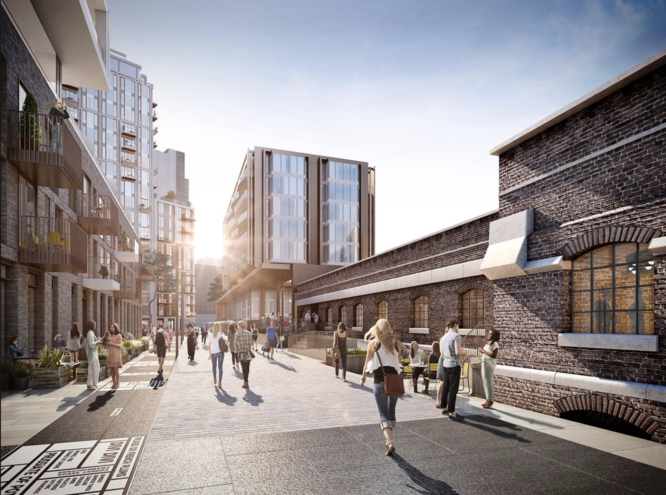London Dock, London - St George City with Patel Taylor

London Dock is a 6.2-hectare transformation of Wapping’s historic docklands into a thriving urban district. Prior to opening in December 2016, the site had been closed to the public since 1799; dock functions, warehouses and the News International print-works that subsequently occupied the site were bound within a walled compound, severed from the surrounding area.
The masterplan breaks down the site’s defensive nature, encouraging movement within, while connecting London Dock to Wapping and beyond. The key to unlocking the site was through a new grid of pathways, public squares and semi-private gardens that draw people into the heart of the development and link the neighbourhood’s spaces and buildings. Complementing this is an exemplary 1,800-home, mixed-use development, described by the press as a “gamechanger” for Wapping.
Accommodation takes the form of core-accessed residential buildings, the majority of which sit on top of a masonry plinth. Different architectural typologies sit above, including towers, linear and terraced blocks. An array of ground-floor commercial and community amenities activate the neighbourhood at street level, including: retail, workspace, restaurants, coffee shops, bars, gym, medical centre and school. The public realm design forges new links from Pennington Street in the north and actively encourages east-west pedestrian movement through the site, physically reconnecting Wapping to Tower Hill and City. While final completion is scheduled for 2030, the occupied buildings and public spaces of Phase 1 are already contributing to Wapping’s social and economic regeneration.
How has it made a promising start on the journey to completion?
London Dock is one of inner London’s largest urban land transformations that successfully reconciles citywide regeneration issues, such as connectivity, mobility, job creation, mixed-tenure homes provision and placemaking. While the nickname “Fortress Wapping” originally related to the News International print workers strike, it was an apt description for the site itself. For London Dock to work in the long term, it needed a strong working relationship with the transitioning city around it.
Today, its network of public spaces seamlessly connects pedestrians through Wapping to Tower Hill and City, contributing to the wider regeneration of East London by increasing urban mobility. In response to local needs, a number of employment, education and retail opportunities are created through integrated commercial and community uses. Wright’s of London moved into London Dock following the success of an initial pop-up café, with Champagne Route soon joining them. The 300-metre Edwardian Grade II Listed Pennington Street Warehouse is solely earmarked for workspace and welcomed its first two tenants, JTP and Assembly Studios, in December 2018.
Current and projected demand for homes at London Dock is high. All homes have been sold at Clipper, Emery, and Admiral & Alexander Wharf (except two penthouses). Due to the openness and equitable nature of Phase 1, the first public spaces of the masterplan, Arrival Square and Gauging Square, are popular destinations for walking, families at play, and workers from the local area enjoying an outdoor lunch. London Dock is already a place where none existed before.
What initiatives have contributed to this new place?
Wright’s of London and Champagne Route are both strong London brands that have been an active draw to London Dock. St George’s themselves have also extended the social experience online through their dedicated London Dock Community Instagram account. Every April, Gauging Square hosts the annual Marathon Market; a highlight in Wapping’s social calendar.
In 2016, Bow Arts Trust were given a short-term lease on Pennington Street Warehouse and incubated over 120 artists in 90 studios at various stages of professional development over 18 months. Their public exhibitions established London Dock as a nascent destination for locals, as well as cementing the building’s creative legacy for the tenants that followed.
The most successful placemaking initiative has been the high-quality architecture and public realm design itself. By structuring spaces around squares and gardens, a framework is established for shared or individual experiences. Touchstones, such as an elegant door handle or balustrade, ignite everyday moments of delight.
Wapping’s docklands history was woven into the design and branding; from the building forms, and public realm artwork, to the nomenclature of buildings and squares; emotionally connecting people to the site’s cultural heritage. Theseconsiderations come together to create a sense of belonging; enhancing the remembered journey – from street to front door and beyond. On a human scale, London Dock shapes a neighbourhood where people from diverse economic and cultural backgrounds can call home. From an urban design perspective, it creates a hierarchy of public spaces that fit together to strengthen the city fabric.
When complete, 30% of homes will be affordable. Currently, Peabody are Registered Provider for 70 homes within Times House (social rent), while 35% of homes at Alexander & Admiral Wharf are affordable (FTB). In terms of environmental enhancements, London Dock will generate 50.1% savings in CO2 emissions, 29.9%savings in unregulated emissions and use 26% less water per person in comparison to similar developments.44% of the masterplan consists of publicly accessible and beautifully landscaped open space.
-
Early bird entry deadline: 15 December 2023
-
Final entry deadline: 25 January 2024
-
Festival of Pineapples: 15-19 April 2024
-
Awards party, London: May 2024
© The Pineapples - Tweak Ltd. 124 City Road, London, EC1V 2NX. Tel: 020 3326 7238
